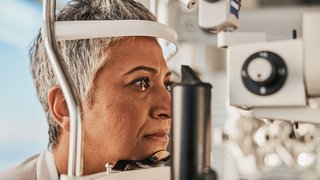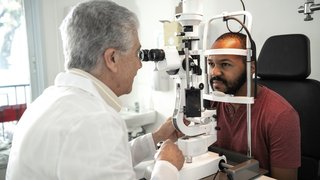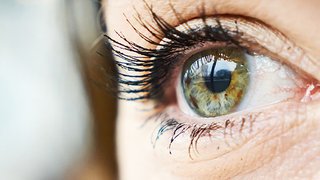How cataract surgical advancements improve recovery
April 9, 2025
R. Wayne Bowman, M.D., Professor in the Department of Ophthalmology, contributed to this article.

Cataract surgery used to be a nightmare for aging adults – patients would often put off care until they could barely see or function. And cataract surgery used to be a lengthy endeavor with an uncomfortable recovery, requiring the patient's head to be stabilized, taking weeks or months away from their usual routines, work, and hobbies.
However, ophthalmologists have seen a profound evolution in cataract surgery in recent years. Advancements in technology and understanding of the eyes allow specialists in the UT Southwestern Department of Ophthalmology to remove cataracts by replacing the cloudy natural lens with new artificial lenses that improve the personalized fit and significantly reduce cloudy vision.
If you’re diagnosed with cataracts, you now have the advantage of broadening eligibility requirements for cataract replacement surgery, more precise procedures, a shorter recovery time, better outcomes, and more treatment options. Let’s discuss what’s changed and what’s on the horizon.
"Advancements in technology and understanding of the eyes allow us not only to remove cataracts but also to use cataract surgery as a refractive procedure, meaning we can better target how well patients see after surgery."
– R. Wayne Bowman, M.D.
Optimizing eye health before cataract surgery means a smoother recovery
In recent years, greater emphasis has been placed on optimizing the health of the eye before surgery.
Dry eye, for example, is a common condition that, if left untreated, increases the risk of complications with any type of eye surgery. Dry eye occurs for many reasons, from seasonal allergies and environmental irritants to long-term contact lens use. It can cause abrasions on the surface of the eye along with inflammation.
The eye relies on moisture to help it heal, and surgery can contribute to dry eye. Ensuring that the surface of your eye is healthy before the procedure can lead to better cataract surgery outcomes.
Measurement systems can help assess any damage to the surface of the eye and make sure your eye surface is ready for surgery. The maps we use are called topographies, and they assess the shape of your eye. One type of topography is called Placido disc technology, which displays a series of colored, concentric rings. Changes in the shape and fidelity of the rings show subtle improvements in eye health over time and tell cataract surgeons a great deal about what needs to be done ahead of surgery (for instance, we often ask patients who have contact lenses to stop wearing them before surgery to heal the eye surface) and which types of lenses are potentially best for you.
Doctor-Driven Consultations
At UT Southwestern, our cataract surgeries are physician-driven. That means the first provider you’ll talk with at your consultation will be a doctor. That way you can get all the options available to you based on your overall health.
Designing your unique lens
Before surgery, our ophthalmologists measure the affected eye with light waves that map its surface using Swept Source noninvasive optical coherence tomography (OCT).
We run the OCT data through complex formulas that use the measurements of the eye’s anatomy and curvature to predict the ideal lens. As these formulas become more precise, so does the likelihood that the lens implanted in surgery will correct your vision.
At the same time, we can customize your replacement lenses based on your needs, meaning we can correct or improve nearsightedness, farsightedness, or astigmatism. This gives many patients the option of whether they want to have fully corrected vision or to retain their reading glasses.
There are also lens formulas, some of which use artificial intelligence, to help predict the ideal power of the implant and how well the patient will be able to see after surgery while driving or doing daily tasks such as working on a computer or reading. These versions of AI are constantly improving, but it is important to remember that the expertise of the ophthalmologist and the rest of the team is crucial for deciding the final type and strength of the lens that replaces a cataract.
Related reading: Cataracts in children: Prevent vision loss with early detection and treatment
Advanced recovery with light-adjustable lenses
In the past, it was impossible to make adjustments once the lens was implanted without additional surgery. But new light-adjustable lenses have transformed post-operative care.
With this technology, the lens is reshaped through UV light after surgery to better fit the shape of the eye. Light-adjustable lenses were created to help better correct the patient’s vision, especially for patients who have had prior surgeries that impact the accuracy of lens-predicting formulas.
The new lens is made of tiny molecules called macromers. When UV light is shined on the lens, the macromers are activated and start sticking together. This makes the lens change shape and alters how well it focuses light (and how well you’re able to see).
We can control where we shine the light to adjust different parts of the lens, making it more curved or less curved depending on what you need to see better. And if we need to make more adjustments later, we can do that by targeting different areas of the lens with the light. Once you’re happy with how the lens is working, we shine a light all over to lock everything in place, so it stays just right for you to see clearly. The entire process takes about six to eight weeks after both eyes have had the lenses implanted with cataract surgery.
This adjustment is noninvasive and painless. It can take three treatments, each 30 seconds to two minutes, to refine the lens and lock it in so that it’s no longer malleable.
Expanding eligibility for cataract treatment
Some surgical centers and standalone vision clinics do not offer cataract surgery to patients with risk factors such as obesity, macular degeneration, and previous retinal detachment. These conditions may increase the risk of surgical complications or require accommodations that those centers are not equipped to handle.
However, patients at UT Southwestern have streamlined access to any specialist care they might need, including cardiology, advanced anesthesia, and emergency medical care. We perform cataract surgery here on our Dallas campus with the latest technology, meaning more patients with complex health needs can safely get cataract surgery.
What to expect during cataract surgery
Fortunately for the vast majority of patients, cataract surgery is an outpatient surgery and with little more than some light sedation and local anesthetic in the form of drops. It is a wonder to many who get the procedure how mild or minimal the side effects of this form of anesthesia can be.
Years ago, recovery could last three months or longer and often involved a hospital stay and immobilization. Our process today is minimally invasive, with smaller incisions that are self-healing without sutures. After surgery, patients can usually resume most of their normal activities like walking, lifting light weights, and doing household chores within a week and even strenuous activities like running, swimming in pools, and heavier lifting after two weeks, depending on the patient’s recovery process.
Related reading: How to prevent infections after eye surgery
The future of cataract replacement surgery
We’re just starting to see what’s possible in cataract surgery, and the digital age will further revolutionize what doctors can do in terms of safety and precision. UT Southwestern is at the forefront of advanced ophthalmologic technology, and new techniques and tools are developed every year. Doctors today have more control over procedures and can provide better results than we could just a few years ago. That said, it’s likely that our current standards might seem outdated in another 10 to 20 years!
Strides have also been made toward increased comfort and accuracy for surgeons performing the procedure. Right now, surgeons look through a microscope, which can be hard on the body. Increasingly, we're working with three-dimensional monitors that project the eye surface so everyone in the room wearing 3D glasses can see it. Not only will this make the procedure more comfortable for the surgeon, but it will also help ensure that ophthalmologists in training can observe these advanced techniques in action. Some companies are designing virtual reality headsets for improved visualization.
Today’s patients can expect precise results and smoother recovery with our advanced procedures. If you’ve been diagnosed with cataracts and are considering surgery or are looking into refractive surgery of any type, we’ll answer your questions and help you choose the best care for your eyes. Call 214-645-2020 today or request an appointment online.











